In the beginning, there was house.
House music is the foundation of a lot of the music we call ‘EDM’ today, with artists like Frankie Knuckles, Larry Levan and Ron Hardy pioneered the genre back in the late 1970’s and early 1980’s.
It’s been around for so long, that it’s developed an innumerable list of subgenres like progressive, deep and future house.
There are even arguments as to what ‘real house music’ is and isn’t.
But we’re not here to argue – we’ve made this guide to help you produce house music, whether it’s festival-banging big room, or dusty, raw Chicago-style deep house.
So in this complete guide on how to make house, we’ll get into:
- How to make interesting 4-on-the-floor drum patterns
- Common synths and basses to use for groove and energy
- When to use FX to add tension and release
- Arranging tracks for club-ready use
- How to make the different subgenres across the spectrum
So no matter which DAW you use (FL Studio, Ableton Live, Logic Pro X or whatever), this guide is for you.
Let’s get started.
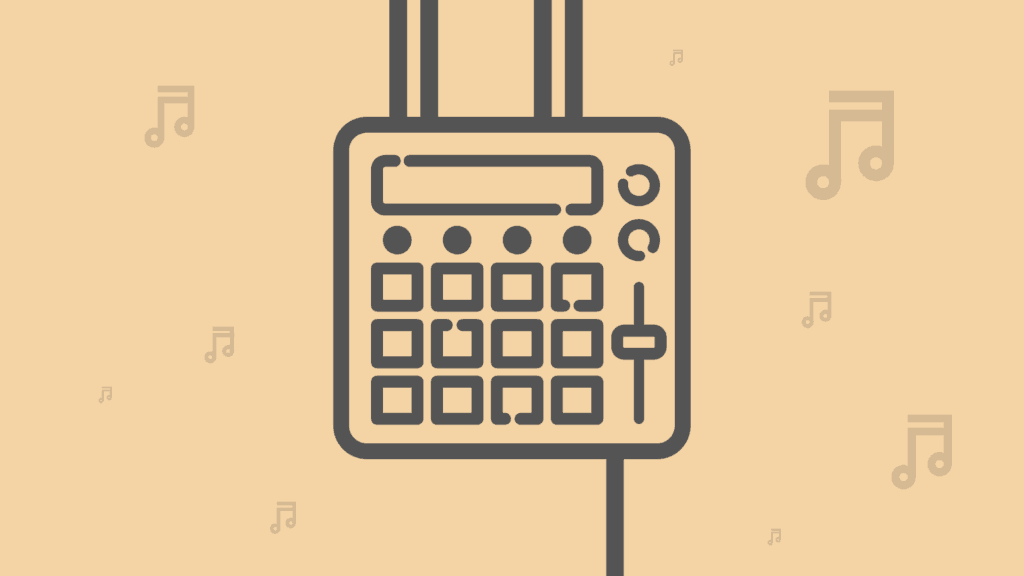
But first, in order to follow along with this guide, make sure to grab our free House Starter Kit! It includes:
- A House Sample Pack with over 70 high-quality drum samples
- A House Preset Pack for Xfer Serum
- A cheat sheet for House production
General Considerations
Some of you may have clicked on this article eager to get into making some house music right away.
But there are a few things to think about before you jump right in, otherwise, you could end up with something completely different to what you were expecting to make.
Don’t Expect To Become a Master
It’s tempting to believe that one tutorial, one article or one piece of advice can solve all of your music production problems.
But that just isn’t true.
This article is designed to give you a basic framework for making house music, but at the end of the day, you still need to put it into practice.
But how can I practice?
Simple. Open up your DAW, make a new project (or open an existing idea) and follow along with this article. Grab the House Starter Kit and play around.
This knowledge is helpful, but you need to develop the skills along with it.
That’s also why we created EDM Foundations – our super-comprehensive course for new producers. Way more than just a tutorial.
Different Subgenres, Different Techniques
Because house music has been around for a very long time, a number of subgenres have been born (and often cause arguments between different house music fans).
You can have both deep, raw house to festival-energy house. So when producing, make sure to consider your goals and the sound you’re going for. Here are the main subgenres (look, sorry if I missed your favourite one):
- Melodic Deep House
- Deep House
- Chicago House
- Acid House
- Future House
- Tech House
- Tropical House
- Progressive House
- Big Room House
- Electro House
- Disco House
- Bass House
Because these subgenres can vary quite a lot, I’m going to be as general as possible with the concepts ahead, and I’ll mention how to adjust them for various styles.
(Also I’m not here to argue what is and isn’t ‘real house music’. This article aims to cater to everyone regardless of what type of house music you want to make).
Standard Elements
House music has always utilized 2 main concepts:
- A four-on-the-floor kick drum rhythm, with a clap on the 2 and 4.
- A tempo of 120-130 BPM
The kick-clap pattern is what makes house music the danceable music it is. It’s a simple yet extremely effective way of keeping rhythm and making people move. The kick underlies most of what goes on in the music, and the clap anchors the listener as to where the rhythm is.
On top of that, hats and other percussion sounds can be utilized in different ways, which we will get into soon.
A tempo of 120-130 is the ideal rhythm for dancing, as it’s not awkward to move to and allows people to feel comfortable. As the BPM approaches 130 and beyond, we start to get into the techno realm of music, where the energy levels are a bit higher and require more energy to keep up with.
Apart from this, everything else is up to the style of house and the decision-making of the producer. So let’s take a look at drums first.
Step 1: Drums
As with many genres of electronic dance music, drums are a staple. They carry the beat, rhythm and energy of the track and are typically the first thing producers create.
Drum Machines
The 707, 808 and particularly the 909 are the core drum machines that gave house music it’s particular sound.
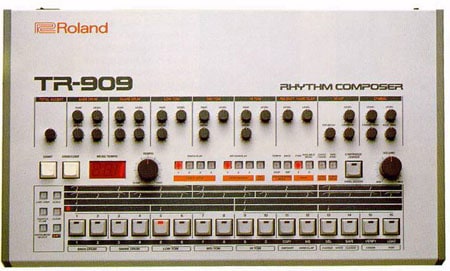
This was because the 909 was popular around the time when house music was born, and many producers used this famed drum machine in completely new ways.
The drums were completely electronic and programmed in over a 1 bar pattern, with the ability to add a sound every 1/16 note. The drums were limited to the sounds on that machine, giving the genre it’s ubiquitous flavor.
Even in modern house production with millions of drum samples at any producer’s disposal, a large amount of the sounds available resemble or are made from the original 909, 808 and 707 sounds. This is a testament to the legacy of those drum machines and how they shaped new genres.
Regardless of the method used to program drums in your modern DAW, it’s important to consider the workflow behind these drum machines in order to replicate the sound of house music:
- 1/16 note programming (can’t go to 1/32 and beyond)
- Sounds: kick drum, snare, 3 toms, rim shot, hand clap, open/closed hi-hat, ride/crash
- On the beat quantization
- Individual volume level control of each drum element
- Velocity control of each drum element (accent certain notes)
- Pitch and length control of each drum element
- Storing and arranging of different drum patterns
- Add shuffle to the pattern
But of course, the pool of available sounds has varied, and this was originally due to samplers like the MPC, but nowadays can be attributed to sample packs and services like Splice Sounds.
So no matter where you get your sounds from, it’s important to consider the workflow that went before.
Recommended: Free Sample Packs
Kick & Clap
The kick-clap rhythm I talked about earlier forms the basis of house music. Here’s how a kick drum sounds at 125BPM:
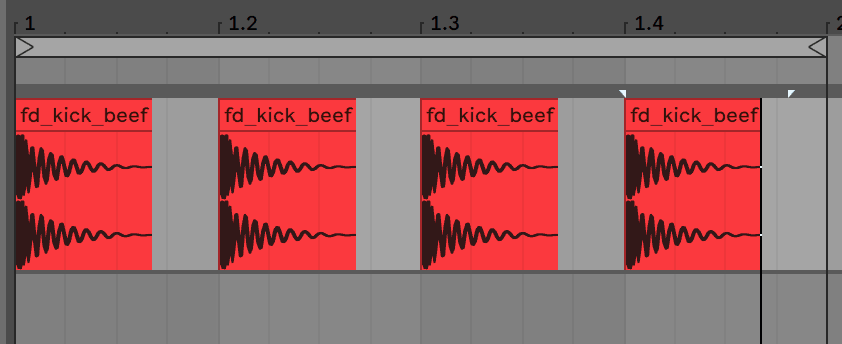
And here’s how it sounds when I add a clap on the 2 and 4 beats:
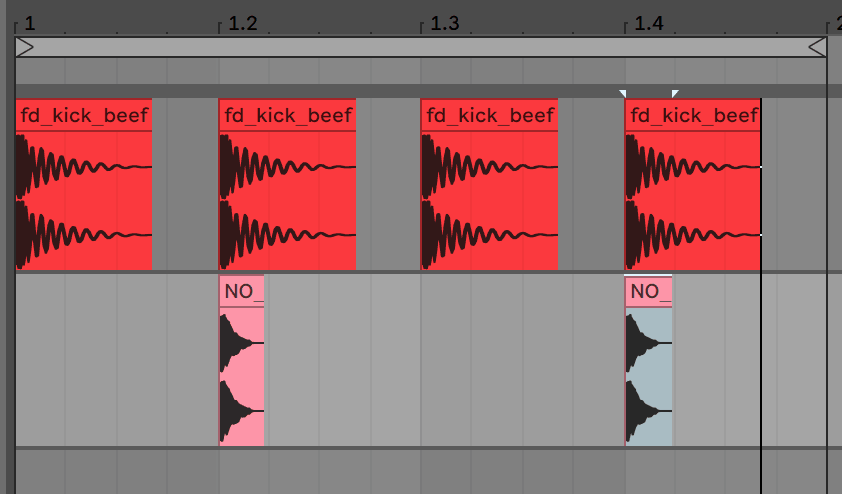
While this is a powerful enough rhythm to make someone dance, it’s quite boring on it’s own. It’s how we ‘decorate’ this simple pattern that makes for an interesting house track.
The first way you can add interest is by varying the patterns up over time, say by adding in an extra clap:
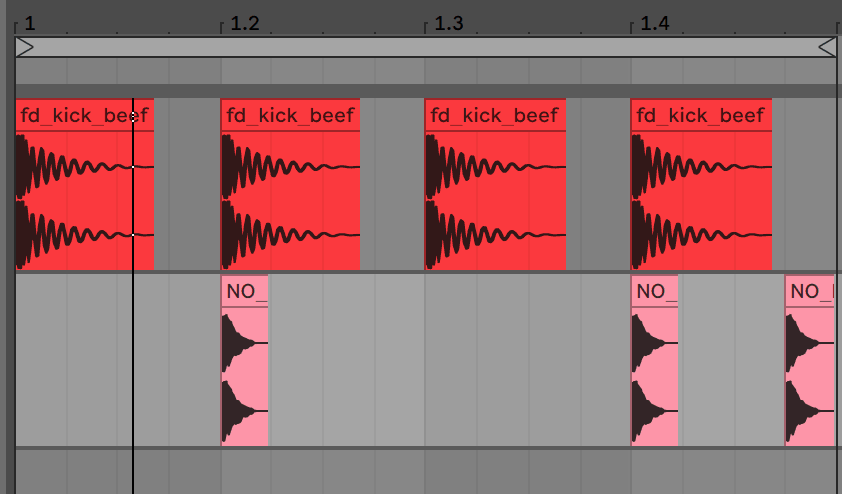
Or by doubling the kick drum on occasion:
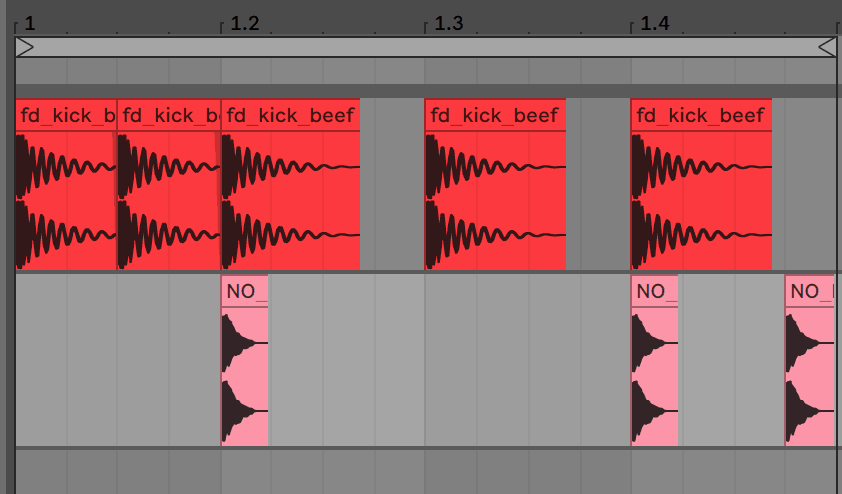
These variations are traditionally arranged in certain patterns, and these patterns repeat over the space of 4, 8 or 16 bar phrases. This keeps house music interesting over time, creating a sense of progression and interest (particularly in genres like progressive house, where the traditional idea is for elements to develop slowly over the course of the whole track).
Note: You can program these either in MIDI with a drum sampler or by dragging the audio directly into the arrangement like I am here.
Hats, Percussion & Groove
The real fun in house music is through the use of percussion loops and one-shots. This is how we get the mysterious ‘groove’ in house music, combined with the bass of course (which we will get into soon).
In fact, many subgenres like tech house and jackin’ house have these interesting rhythms as the focal point of the music.
The main use of hats in house music is the classic offbeat hi-hat. This provides a steady sense of rhythm throughout the whole track.
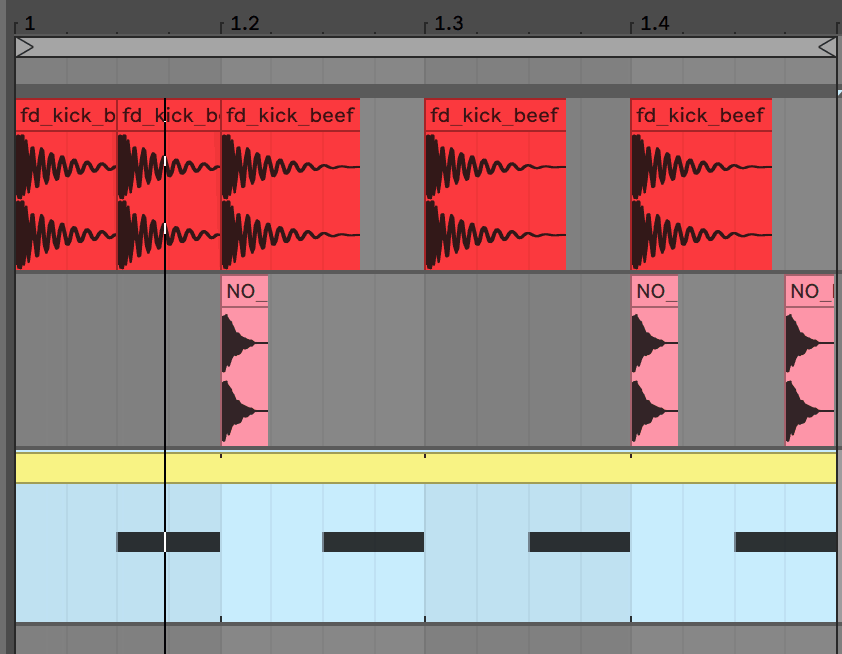
This can get boring of course, so often the pattern may switch up to use a more open hi-hat sound.
Apart from the standard offbeat hats, other hats can ‘dance around’ the steady beat in intervals of 1/16 notes, creating a pleasant rhythm. Here’s a basic example:
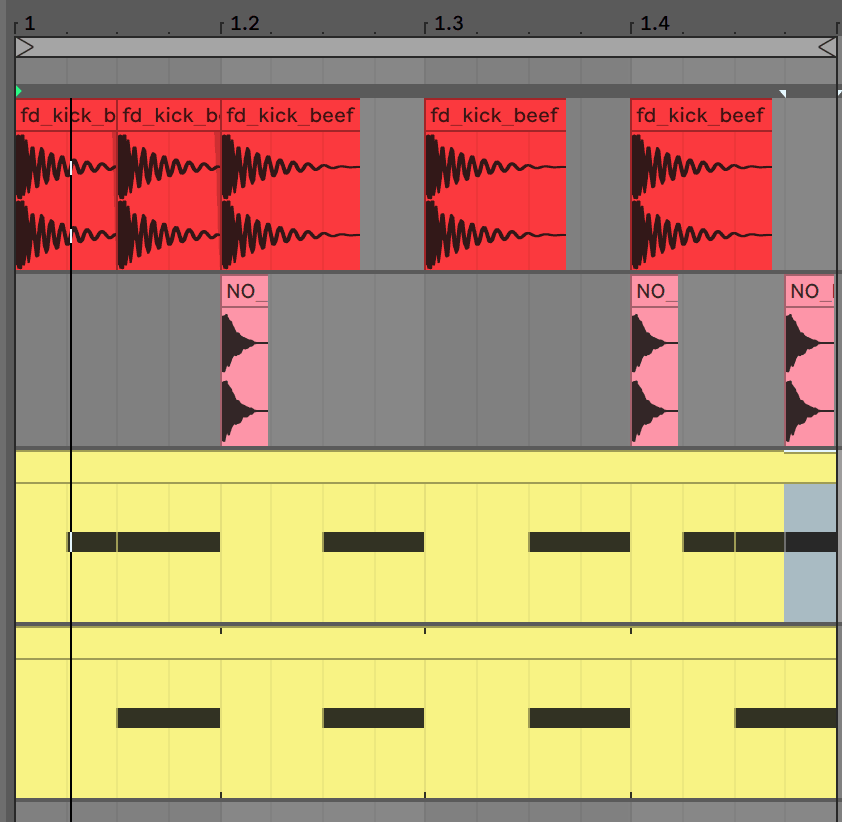
Notice how certain hits feel more emphasised than others? This contributes to the sense of ‘groove’ in the pattern and is aimed at creating more humanized drums.
In many subgenres, this is where a lot of the interest comes from. But in others where the melody, vocal, bassline or sound design is the focus, the drums may stay in this more stripped-back form without lots of off-beat emphases.
To furthermore get a human feel, it’s not uncommon to add shuffle or swing to the drums. This is normally achieved by moving every 2nd 1/16 note slightly later than it ‘should’ be, and it entirely changes the feel of a drum groove.
Most DAWs have a swing/groove setting that allows the producer to dial this in at a selected amount. The more shuffle, the more ‘urgent’ the pattern can feel.
Note: For those of you in Ableton Live, the Groove Pool is the best way to add shuffle in house music.
There are a selection of presets available, but for this style the MPC 16 presets offer a variety of shuffle amounts. I personally like to use the MPC-16 65 preset.
If you’re in FL Studio, the step sequencer has a slider up the top, allowing you to dial in the desired amount of 1/16 shuffle.
Also, don’t be afraid to use loops in this case. Loops can add instant groove to a track and often layering them with other loops and patterns can help create different types of unique grooves.
Taking It Further
All things considered, it can start to seem like house music has a lot of ‘rules’ on how drum grooves should sound.
But with modern DAWs, there are endless possibilities, and you can extend a lot of these principles beyond the ‘traditional’ house music sound.
For example, a lot of house music makes use of a ‘pre-shifted clap’. That is a clap that plays around 20ms or more before the beat of the kick drum, to add a more natural feel.
Or you can use sampled live drums instead of drum machines or both. In fact, a lot of earlier house used MPC’s to sample drums like hip-hop producers would, but nowadays there is a lot more material out there to use.
There’s no need to feel tied down, especially if you’re going for a more modern take on house music like big room, melodic house or bass house.
Step 2: Bass
Dance music isn’t complete without deep, warm bass, and house is the furthest from an exception to the rule. Here’s how to approach writing bass lines.
Rhythm
Basslines and rhythm are synonymous in house music.
Why? Because it contributes to the groove of the track just as much as the drums. This is achieved by writing basslines that place emphasis on ‘syncopated rhythms’.
Syncopated rhythms sound like the following, in the context of a house drum beat.

You can hear that it sounds a great deal more interesting than a simple ‘on the beat’ bassline.

Following this principle of syncopation, we can write basslines that move up and down the scale and place rhythmic emphasis on the offbeat. If you need a variety of bassline writing tips, check out our guide on writing better basslines.
Notes & Frequency Range
The frequency range of the bassline is very dependant on the subgenre. Traditionally, the kick filled out the sub-range and the bassline sat on top of that filling the main bass range.
This relationship allows the groove to carry forward, as the lower-kick is nicely balanced as an anchor between the kick drum and the bass.

This is true even in genres like big room house, where the sub-kick as a lot more clear tonality and fills out all the bottom end, leaving space for a lead on top only.
However, in some modern genres like bass house and future house, the bassline often fills up a greater amount of the spectrum. In this case, the kick is more high-passed and provides the upper-bass thump but not as much low end.
Groove is less important in these types of genres, where the sound design and bass sound is more important than the role it plays in the overall composition.

Basically, you want to make sure that the kick and bass leave space for each other. If there’s a lot of overlap (which is the case in some genres) you can use tools like sidechain compression to duck the bass out of the way when the kick hits, but we’ll get to that later.
Recommended: EQ: The Ultimate Guide
As for the notes, most basslines would follow a minor pentatonic scale, which is basically the ‘you can’t go wrong here’ scale.
Let’s take A Minor for example. The notes in that scale are:
A, B, C, D, E, F and G
But in the Minor Pentatonic scale, you omit the 2nd and the 6th notes, so you get:
A, C, D, E and G
This scale sounds good because often the 2nd and 6th notes don’t harmonise well with every chord in the scale. So it’s a safe bet, and there is plenty of room for creativity.
In fact, it’s actually a technique used in a lot of funk music. So you know it’s gonna sound good.
Note: if you want to delve more into the theory, we cover pentatonic writing in detail in our Songwriting for Producers course.
Sound Design
The sounds chosen for the bassline are very subgenre-dependant.
For example, in some genres like tech house and deep house, a plucky, darker filtered bass sound may be used.
Something like this is designed to hit the same spot that a traditional bass guitar through an amp would sound like. Short decay times, filter envelopes and a bit of saturation is the name of the game here.
But in a future house track, a brighter, FM-style pluck may be used to poke out of the mix more.
In these cases, the sound of the bassline is crucial to the integrity of the track. It’s loud, it’s compressed and it wants to be paid attention to.
These modern basslines might use OTT, FM synthesis and limiting to help achieve their iconic sound.
Or you might want an analogue-style reese bass in a melodic deep house track, like something you’d find on Anjunadeep.
These sounds might function similarly to a real bass guitar too, but the notes may be more drawn out and work well with the chords, creating more of a progressive feel.
There are no particular rules here, so go nuts!
Recommended: 100 Sound Design Tips
Step 3: Instruments
Drums and bass are normally considered the most crucial elements in house music, but the chords, melodies and vocals are what gives it soul and an overall vibe.
Chords
Traditionally, chords in house music were sampled from other music (seventh and ninth chords from soul, funk and jazz records) and were pitched around in a sampler to give a dissonant yet ‘vibey’ feel.
A classic example of this Inner City’s ‘Good Life’:
Here’s a similar example you could replicate in the DAW over a standard house drum pattern.
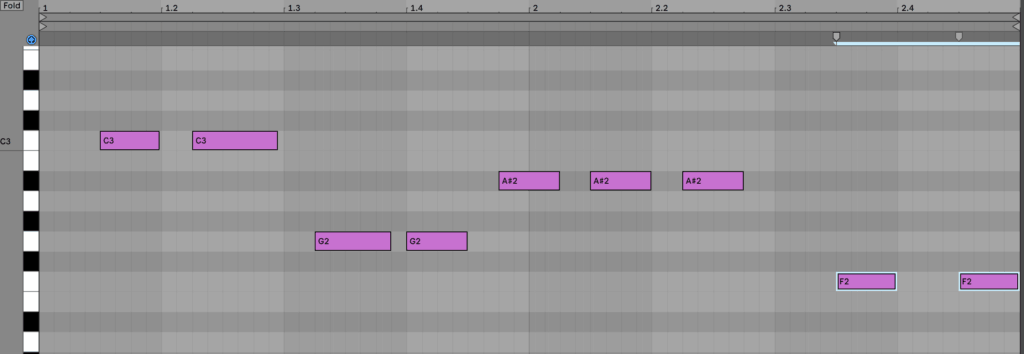
The chord sound is loaded up into Ableton Live’s Simpler and a simple pattern is played in with some delay.

Note that we only need to play one note at a time here as the chord is already embedded into the sample.
If we were playing a synth or piano instrument, we would need to program in the individual notes of the chord into MIDI.
But a lot of contemporary house music has begun to borrow elements from other electronic and non-electronic genres like trance, dubstep, pop, and even rock.
Consider something like Swedish House Mafia’s ‘Don’t You Worry Child’, a melodic big room house anthem.
The chords here sound a lot more trance-y then they do house-y. But that’s okay.
Melody
Once again, if we look back at the history of house music, we find that a lot of the music would sometimes feature snippets of sampled vocals, or sometimes have a groovy synth lead as the ‘hook’ of the track (especially in the more disco-oriented house tracks).
Looking at a classic track like Moby’s ‘Go’, the interplay between the pad, the piano stab and the vocal create the hook.
But it’s really the ‘yeahhhh’ vocal that draws the listener in. That vocal snippet is likely sampled from another song.
In a more commercial house sense, the melody is normally played by a bright lead and/or is implied by the top note of the chord.
Consider the classic ‘Pjanoo’ by Eric Prydz. The piano chords are the focus of the track, but it’s really the top note of the chord and the violin that comes in that create the melody.
We can see how this would look in the DAW here on top of the bassline:
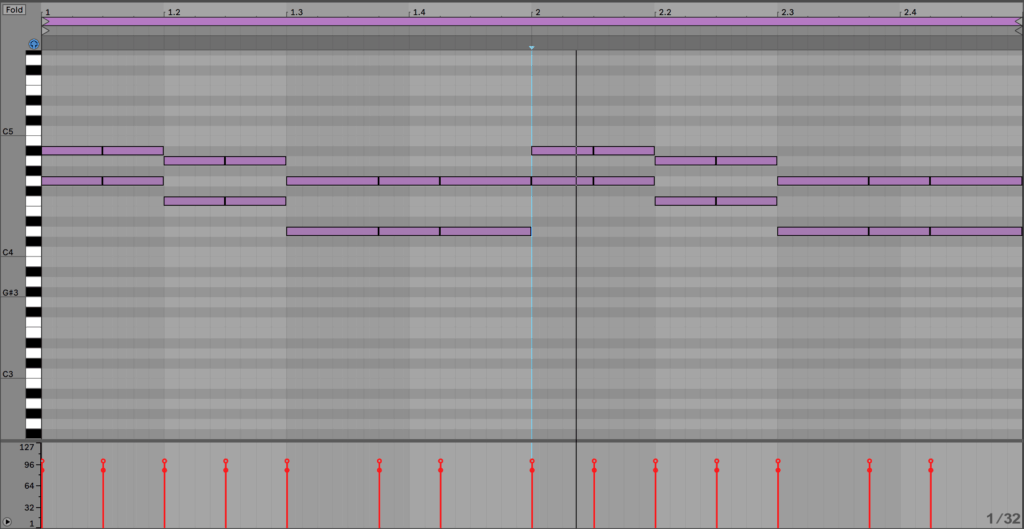
So the unity of the chords and melody is very important, even if the melody doesn’t follow the exact same rhythm.
Step 4: FX
The use of effects in house music can range from the subtle to the outrageous, depending on the result you are going for.
The main categories of effects can be broken down into the following:
| Effect Type | Description |
| Sweep/Riser/Uplifter | A medium-to-long sound that spans at least a bar, increasing in energy through the use of pitch modulation, filtering and other processing. |
| Crash/Impact | A one-shot sound at the start of a bar, section or somewhere, indicating a change and adding energy (e.g. at the start of the drop) |
| Downlifter | A medium-to-long sound that spans at least a bar, lowering the energy level or signifying the end of tension being built. |
| Creative FX | Not something that can be strictly defined, but anything that adds texture, movement or interest to a track (e.g. static white noise, vinyl crackle, spoken word dialogue etc.) |
In more energetic and commercial forms of house music, you can have loud, mid-range FX that drastically scale up the energy leading into a drop or new section.
Consider something like ‘Feel The Volume’ by Jauz, which is a modern bass house track.
At 0:46 we start to hear a snare getting faster among multiple synth sounds rising in pitch. A great deal of tension is being created here, leading into the drop which features some FM-type bass sounds and a nice drum groove.
Yet in more groove-oriented forms of house music like deep house and tech house, FX are normally more subtle sweeps in the background that create pull and release over the duration of the track. They also commonly feature reverb and delay to ‘push them back’ in the mix.
Consider something like ‘Suki’ by Black Loops.
The sweep FX used at 1:55 onwards to lead into the ‘drop’ are extremely subtle and are used only to subconsciously indicate a change is coming.
This is achieved not only by having it quieter in the mix but also by using something without much character – white noise with a simple filter sweep and some reverb.
Step 5: Arrangement
One thing house music is known for is the arrangement.
Elements are subtle brought in and out and develop the track over time so that even tracks with structures longer than 6 minutes remain interesting throughout.
Let’s take a look.
Structure
House music can range from the length of a typical pop song (3-4 minutes) all the way up to a longer progressive journey (8-10 minutes).
For this reason, the structure and sections can look very different for each subgenre.
One thing to consider is the typical addition of a DJ intro and outro for longer tracks. This usually manifests itself as at least 16 bars either side of a ‘radio-friendly’ structure, allowing it to be mixed in easily within a club or live context.
This can easily add an extra 1-2 minutes onto the existing structure, which is why a lot of house tracks end up being 4-6 minutes, if not longer.
If you’re aiming for Spotify and streaming-friendly music, skip the intro and outro. If you’re aiming for DJ playability, keep the intro and outro.
You can even have multiple versions for different platforms – an extended mix/original mix on platforms like Beatport and Bandcamp, and a radio edit on Spotify, Apple Music and other stores.
So first, let’s take a look at an overall ‘original mix’ structure:
DJ Intro (16-32 Bars) – Breakdown (16-32 Bars) – Drop (16-32 Bars) – Drop Variation (Optional) (16-32 Bars) – Breakdown (16-32 Bars) – Drop (16-32 Bars) – Outro (16-32 Bars)
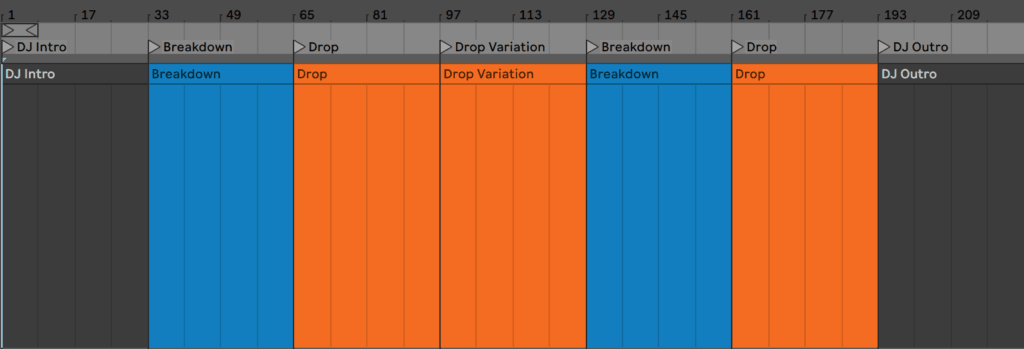
Most sections last either 16 or 32 bars, with subtle changes happening every 8 bars or so.
But if we remove the DJ Intro, remove the DJ Outro and shorten some of the sections, we get a ‘radio-friendly’ version:
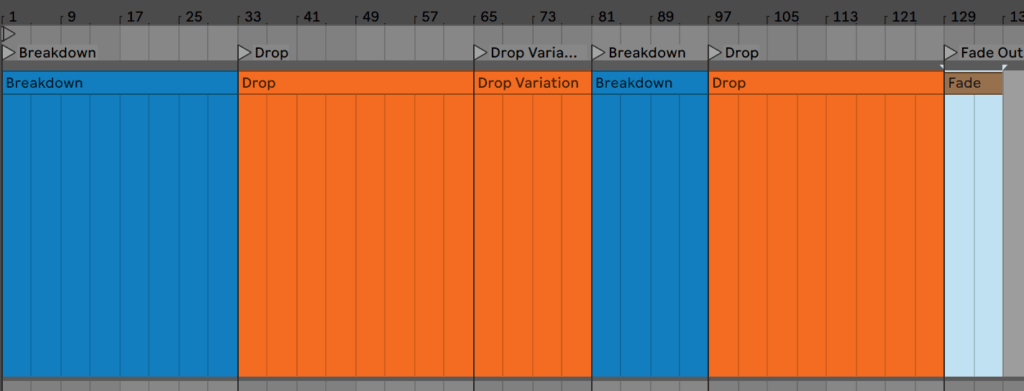
Instrumentation & Layering
We’ve already covered the main elements that are included in a typical house track – drums, bassline, chords, lead/vocal and FX.
House music utilizes these elements by making subtle changes over time, not only by bringing certain instruments in and out or changing them, but also through the manipulation of:
- Volume
- Filtering
- Reverb/Delay
- Addition of Flanger, Phasers and Choruses
- Other FX
Consider the classic ‘Lovelee Dae’ by Blaze. Notice how in the intro the string samples fade in over the span of 16 bars or so?
This slow volume fade adds tension to the intro of the track, more so than just having the sample play at full volume from the start.
Step 6: Mixing & Mastering
Mixing and mastering are crucial to getting your music up to the standard of other tracks in house, so make sure to follow this section all the way through.
We won’t go into a lot of depth here, but if you want an overall mixing resource, check out our Mixing EDM guide.
Mixing
We all want a clean, loud and balanced mix, right?
Well, we achieve that by a series of mixing decisions, starting with volume.
Volume
Of all the mixing advice we’re going to get into, the individual track volume is by far the most important to pay attention to.
Because EQ and compression can’t fix a poorly-balanced mix.
One of the first things you’ll want to do when starting a proper mixdown (which you should do even if you’ve mixed along the way) is balancing your individual faders to get as clean of a mix as possible.
Think of your fader mix to be like a more detailed form of overall master-EQing – you have way more control over the elements and it can help clean up the entire track.
EQ
Once you’ve got a balanced mix, EQ can often help clean up a lot of problems.
The most important thing to do is high-pass most elements to clean up the mix, leaving space for the kick and bass, which is crucial for any sort of dance music.
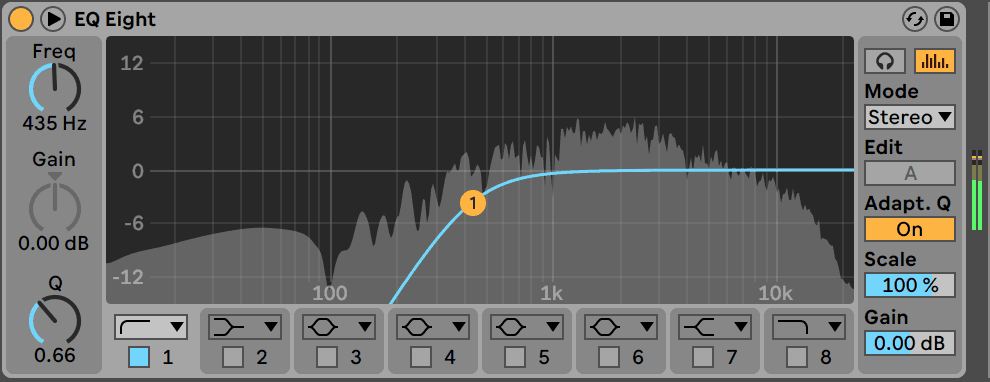
An important factor here is to make sure you choose an appropriate cutoff frequency.
Too high and you’ll thin out the rest of your mix.
Too low and you’ll still get clashing and muddiness.
Compression
Compression is heralded as one of the holy grails of mixing any sort of electronic music. But quite often, it is misused and over-relied on.
The whole point of compression is to even out any sort of audio material, but a lot of electronic music is made from synthesized sources, which has quite consistent and controllable volume in the first place.
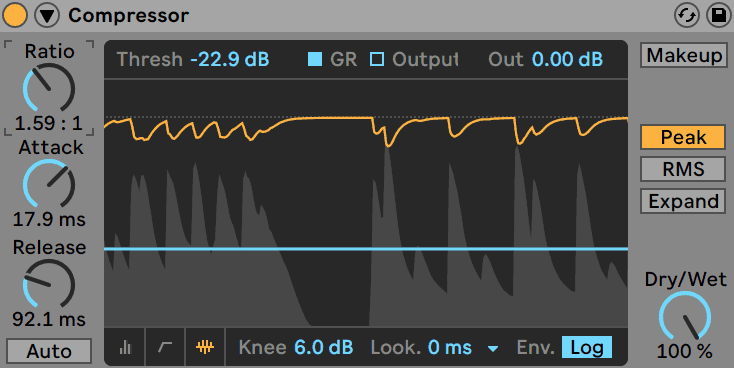
The way I like to approach compression is by applying little amounts to massage the sound, preparing it for more compression during the mastering stage, dialling it in a bit more when dealing with inconsistent and/or organic audio sources (like recorded sounds).
However, when in doubt, don’t use compression. Many of the samples you get from sites like Splice already have compression, limiting and EQ to make them work straight out of the box.
Sidechain Compression
In many subgenres of house, sidechain compression is crucial, particularly between the kick and bass.
What’s I’m referring to is that ducking/pumping sound you hear every time the kick hits. You can hear it emphasized in genres like big room house and bass house.
This Cash Cash remix of Krewella’s Alive is a good example:
Traditionally, you can set this up by using your DAW’s native compressor and enabling the sidechain function.
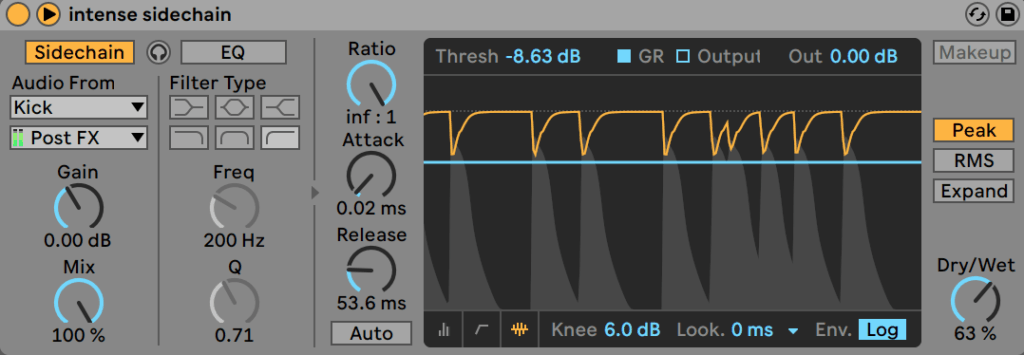
However, there are many other tools you can use to achieve a ‘tighter’ sidechain sound that use volume automation instead, like Xfer LFOTool or Nicky Romero Kickstart.
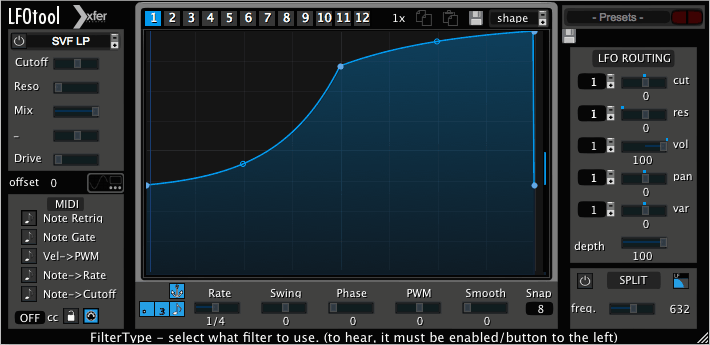
Recommended: Mixing For Producers
Mastering
If you’re taking mastering into your own hands, here are a few key plugins/devices and techniques you should be using (context permitting).
Buss Compression
Buss compression helps to add a sense of ‘togetherness’ to a mix, instead of it sounding like a series of separate tracks.
Using an analogue-style compressor in this situation helps as they tend to have a character that adds something else other than straight compression to the track.
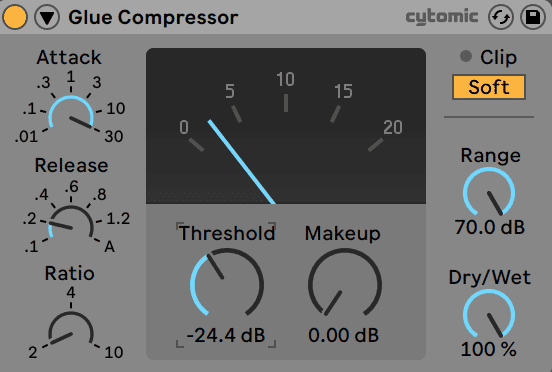
I tend to use Ableton Live’s Glue Compressor at this stage, but you can use any type of compressor that you desire.
Just note that not every kind of analogue compressor will sound good for mastering applications, especially when pushed hard. So always use your ears first, and when in doubt, use nothing.
Multiband Compression
If you’re going for a high-energy club-type house, or you want a super controlled and balanced mix, then multiband compression can be a great tool.
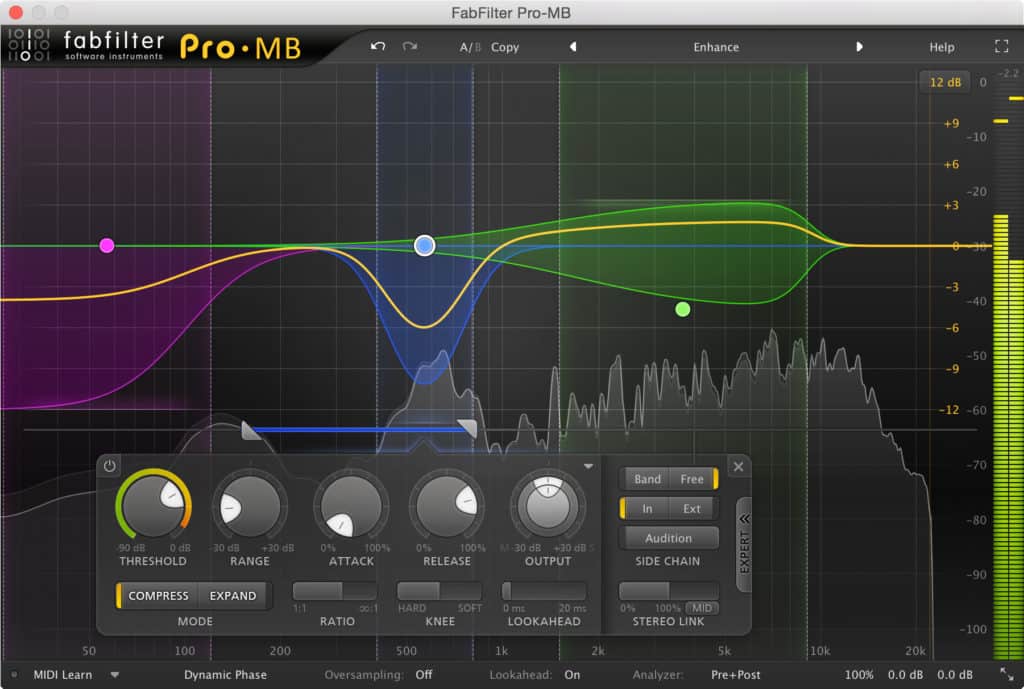
If using it on the master, you want to be very subtle and use it as transparently as possible. In fact, often I tend to only process either the lows, highs or a very narrow range of resonant frequencies.
Limiting
Of course, you can’t have a mastered track without some solid limiting – usually last on the mastering chain.
The best way to use a limiter is to compare your mastered track with a reference track and push the loudness to a similar level.
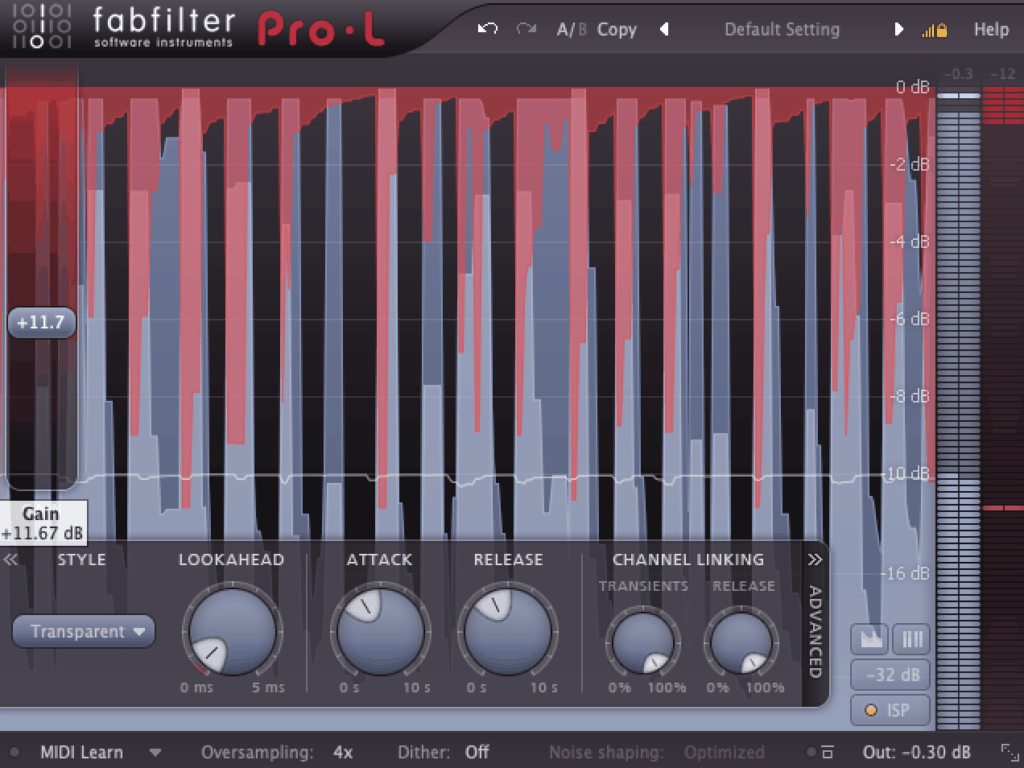
Combine this with something like the YouLean Loudness Meter to get all of the necessary measurements when mastering, like LUFS. That way, you can compare your track to the measurements of other tracks.
And that’s it! If you followed the rough outline of this guide, you can end up with a finished house track of your own!
Want Some Samples?
Make sure to grab our House Starter Kit, with 70+ samples, 30+ Serum presets and a cheat sheet for house music production.
Any questions? Hit me up at [email protected].
